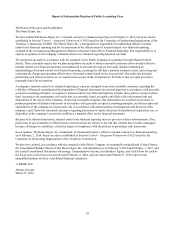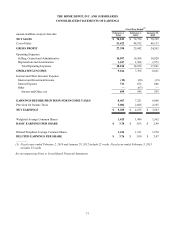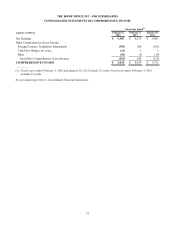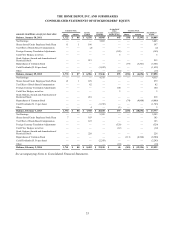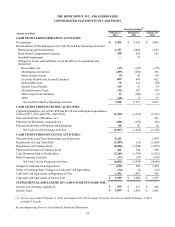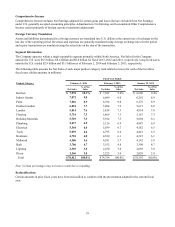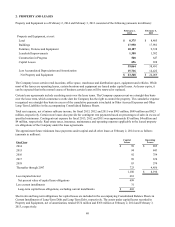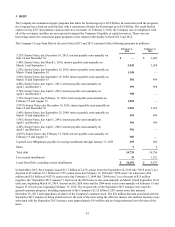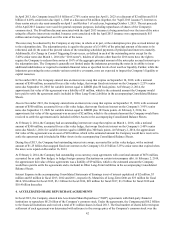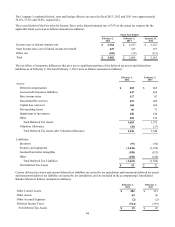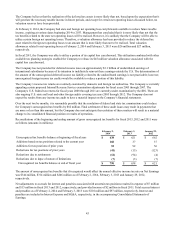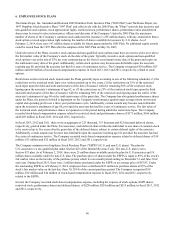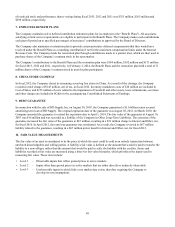Home Depot 2013 Annual Report Download - page 43
Download and view the complete annual report
Please find page 43 of the 2013 Home Depot annual report below. You can navigate through the pages in the report by either clicking on the pages listed below, or by using the keyword search tool below to find specific information within the annual report.
38
Impairment of Long-Lived Assets
The Company evaluates its long-lived assets each quarter for indicators of potential impairment. Indicators of impairment
include current period losses combined with a history of losses, management’s decision to relocate or close a store or other
location before the end of its previously estimated useful life or when changes in other circumstances indicate the carrying
amount of an asset may not be recoverable. The evaluation for long-lived assets is performed at the lowest level of
identifiable cash flows, which is generally the individual store level.
The assets of a store with indicators of impairment are evaluated by comparing its undiscounted cash flows with its carrying
value. The estimate of cash flows includes management’s assumptions of cash inflows and outflows directly resulting from
the use of those assets in operations, including gross margin on Net Sales, payroll and related items, occupancy costs,
insurance allocations and other costs to operate a store. If the carrying value is greater than the undiscounted cash flows, an
impairment loss is recognized for the difference between the carrying value and the estimated fair market value. Impairment
losses are recorded as a component of SG&A in the accompanying Consolidated Statements of Earnings. When a leased
location closes, the Company also recognizes in SG&A the net present value of future lease obligations less estimated
sublease income. The Company recorded impairments and lease obligation costs on closings and relocations in the ordinary
course of business, as well as for the closing of seven stores in China in fiscal 2012, which were not material to the
Consolidated Financial Statements in fiscal 2013, 2012 or 2011.
Goodwill and Other Intangible Assets
Goodwill represents the excess of purchase price over the fair value of net assets acquired. The Company does not amortize
goodwill but does assess the recoverability of goodwill in the third quarter of each fiscal year, or more often if indicators
warrant, by determining whether the fair value of each reporting unit supports its carrying value. Each year the Company may
assess qualitative factors to determine whether it is more likely than not that the fair value of each reporting unit is less than
its carrying amount as a basis for determining whether it is necessary to complete quantitative impairment assessments, with
a quantitative assessment completed at least once every three years. In fiscal 2013, the Company elected to estimate the fair
values of its identified reporting units using the present value of expected future discounted cash flows.
The reporting units assessed for impairment during fiscal 2013 were U.S., Canada and Mexico. During fiscal 2013, the
Company determined that its goodwill balances for each of these reporting units were not impaired, as the Company
determined the fair value of each of these reporting units was substantially above its carrying value. In fiscal 2012, the
Company recorded a charge of $97 million to impair all of the goodwill associated with the former China reporting unit.
There were no impairment charges related to the remaining goodwill for fiscal 2013, 2012 or 2011.
The Company amortizes the cost of other intangible assets over their estimated useful lives, which range up to ten years,
unless such lives are deemed indefinite. Intangible assets with indefinite lives are tested in the third quarter of each fiscal year
for impairment, or more often if indicators warrant. There were no impairment charges related to other intangible assets for
fiscal 2013, 2012 or 2011.
Stock-Based Compensation
The per share weighted average fair value of stock options granted during fiscal 2013, 2012 and 2011 was $13.10, $9.86 and
$7.42, respectively. The fair value of these options was determined at the date of grant using the Black-Scholes option-pricing
model with the following assumptions:
Fiscal Year Ended
February 2,
2014 February 3,
2013 January 29,
2012
Risk-free interest rate 0.8% 1.2% 2.0%
Assumed volatility 26.3% 27.0% 27.3%
Assumed dividend yield 2.2% 2.3% 2.7%
Assumed lives of options 5 years 5 years 5 years
Derivatives
The Company uses derivative financial instruments from time to time in the management of its interest rate exposure on
long-term debt and its exposure on foreign currency fluctuations. The Company accounts for its derivative financial
instruments in accordance with the Financial Accounting Standards Board Accounting Standards Codification ("FASB ASC")
Subtopic 815-10. The fair value of the Company’s derivative financial instruments is discussed in Note 10.


